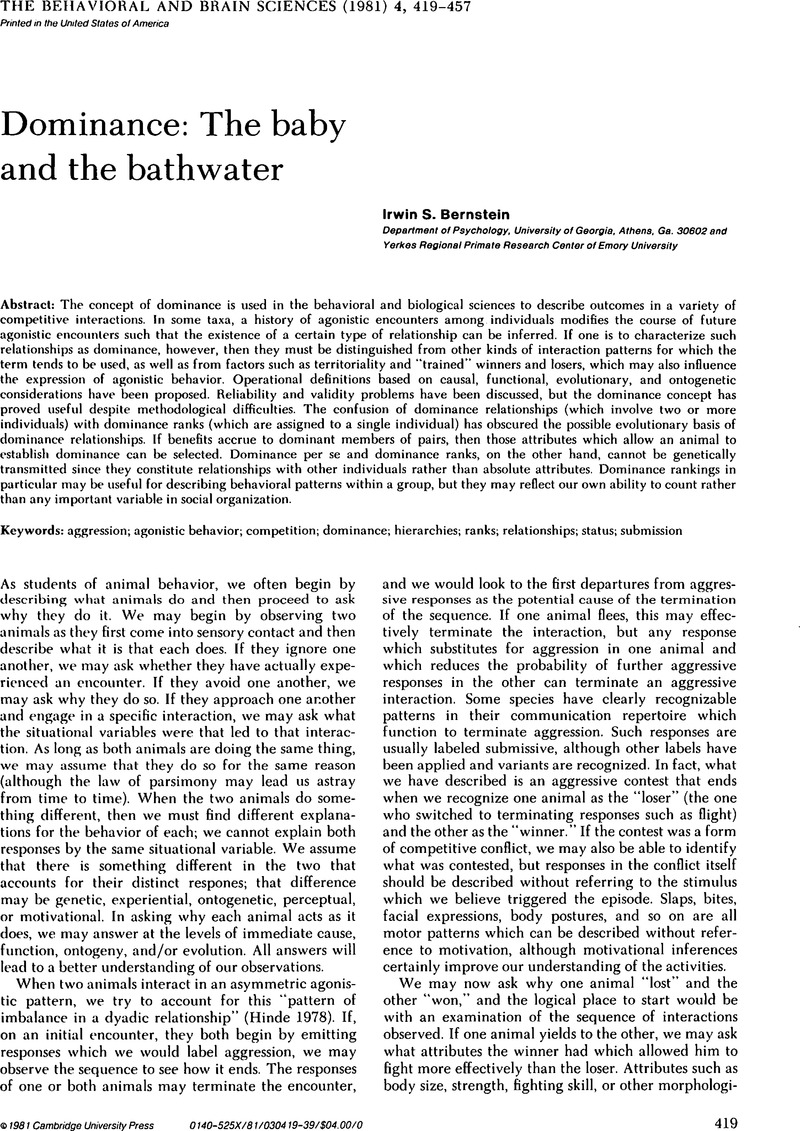Crossref Citations
This article has been cited by the following publications. This list is generated based on data provided by Crossref.
Bernstein, Irwin
1983.
Agreements on dominance!.
Behavioral and Brain Sciences,
Vol. 6,
Issue. 2,
p.
338.
Ursin, Holger
and
Myhre, Grete
1983.
Instrumental effects of agonistic behavior.
Behavioral and Brain Sciences,
Vol. 6,
Issue. 2,
p.
338.
Mckenna, James J.
1983.
The dominance concept: We agree more than we realize.
Behavioral and Brain Sciences,
Vol. 6,
Issue. 2,
p.
335.
Delgado, José M. R.
1983.
Dominance, hierarchy, and brain stimulation.
Behavioral and Brain Sciences,
Vol. 6,
Issue. 2,
p.
334.
Barnett, S. A.
1983.
Dominance: An empirical finding or a platonic idea?.
Behavioral and Brain Sciences,
Vol. 6,
Issue. 2,
p.
334.
Rosenblum, Leonard A.
and
Schwartz, Gary G.
1983.
Dominance: Strategy is the name of the game.
Behavioral and Brain Sciences,
Vol. 6,
Issue. 2,
p.
337.
Brennan, J.
and
Anderson, J. R.
1988.
Varying responses to feeding competition in a group of rhesus monkeys (Macaca mulatta).
Primates,
Vol. 29,
Issue. 3,
p.
353.
Rasmussen, D. R.
and
Farrington, M.
1994.
Relationships between position in the central-peripheral structure, age, and the dominance index in the tanaxpillo colony of stumptail macaques (Macaca arctoides).
Primates,
Vol. 35,
Issue. 4,
p.
393.
Rasmussen, D. R.
Riordan, E.
Farrington, M.
Kelly, E.
Nachman, J.
Fernandez, S.
and
Churchill, A.
1994.
The Ethological Roots of Culture.
p.
41.
Hawley, Patricia H.
1999.
The Ontogenesis of Social Dominance: A Strategy-Based Evolutionary Perspective.
Developmental Review,
Vol. 19,
Issue. 1,
p.
97.
de Luca, D.W.
and
Ginsberg, J.R.
2001.
Dominance, reproduction and survival in banded mongooses: towards an egalitarian social system?.
Animal Behaviour,
Vol. 61,
Issue. 1,
p.
17.
Despret, Vinciane
2009.
Quand les mâles dominaient....
Ethnologie française,
Vol. Vol. 39,
Issue. 1,
p.
45.
Schilder, Matthijs B.H.
Vinke, Claudia M.
and
van der Borg, Joanne A.M.
2014.
Dominance in domestic dogs revisited: Useful habit and useful construct?.
Journal of Veterinary Behavior,
Vol. 9,
Issue. 4,
p.
184.
2014.
Free‐Ranging Cats.
p.
251.
da Silva, Suleima do Socorro Bastos
Guimarães, Diva Anelie
Biondo, Cibele
Ohashi, Otávio Mitio
de Albuquerque, Natália Inagaki
Vecchia, Ana Carolina Dalla
Miyaki, Cristina Yumi
and
Le Pendu, Yvonnick
2016.
Dominance relationships between collared peccaries Pecari tajacu (Cetartiodactyla: Tayassuidae) in intensive breeding system.
Applied Animal Behaviour Science,
Vol. 184,
Issue. ,
p.
117.
Finn, Kelly R
and
Hasenjager, Matthew
2021.
Multilayer network analyses as a toolkit for measuring social structure.
Current Zoology,
Vol. 67,
Issue. 1,
p.
81.
Lewis, Rebecca J.
2022.
Aggression, rank and power: why hens (and other animals) do not always peck according to their strength.
Philosophical Transactions of the Royal Society B: Biological Sciences,
Vol. 377,
Issue. 1845,
Strauss, Eli D.
Curley, James P.
Shizuka, Daizaburo
and
Hobson, Elizabeth A.
2022.
The centennial of the pecking order: current state and future prospects for the study of dominance hierarchies.
Philosophical Transactions of the Royal Society B: Biological Sciences,
Vol. 377,
Issue. 1845,



